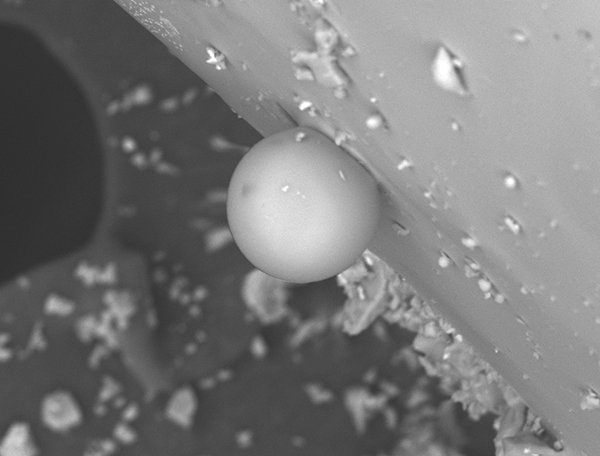
by Cortney Cameron Friday, August 7, 2015

Within the ash plumes of explosive volcanic eruptions, collisions among countless pyroclastic particles sometimes lead to the buildup of static charges that discharge dramatically as volcanic lightning. In a new study, researchers have found that this lightning can, in turn, melt and fuse ash particles into distinctive glassy grains called spherules. Identifying and studying these spherules could help scientists better understand past and future eruptions, the study’s authors suggest.
In volcanic plumes, regions or layers of oppositely charged particles develop naturally; typically “the higher region of a plume is positively charged, while the ground and the plume’s lower region are negatively charged,” says John Wardman, a geologist at the University of Canterbury in New Zealand and co-author of the new study published in Geology. “When the net difference of charge between two regions is sufficiently high, a discharge [lightning bolt] occurs between the two regions.” This lightning can reach 30,000 degrees Celsius for several milliseconds — more than enough to melt fine ash particles, which then shape into spherules as they fall through the air and cool rapidly.
Researchers had previously found that large meteorite impacts, typical cloud-to-ground lightning strikes, and magma fountain-forming eruptions could produce spherules ranging in diameter from a few microns to a few centimeters. But until now, the formation of lightning-induced volcanic spherules, or LIVS, had not been confirmed.
Wardman and his colleagues examined samples of ashfall deposits from a pair of volcanic eruptions that featured extensive volcanic lightning: the March 2009 eruption of Alaska’s Mount Redoubt and the 2010 eruption of Iceland’s Eyjafjallajökull. In samples from both, they found silica-rich spherules with diameters less than 100 microns (roughly the width of a human hair) and smooth, cracked surfaces — features that resemble those of spherules produced by other processes.
To verify that what they’d found in the field were indeed LIVS, the researchers turned to the lab to replicate the process of volcanic lightning hitting volcanic ash. The team contaminated high-voltage insulators with basaltic “pseudo-ash” (created with pulverized rock), and then induced flashover, or electrical arcing, across the insulators. Wardman says he was initially “skeptical about whether we were generating sufficiently high temperatures” to melt and fuse the experimental ash, but that he “became very excited when we found spherules in our pseudo-ash samples,” a finding that confirmed volcanic lightning’s ability to form LIVS in nature.
Time-lapse photograph of volcanic lightning produced during an explosive eruption at Alaska's Mount Redoubt in 2009. Credit: Ryan Bierma, Alaska Volcano Observatory/U.S. Geological Survey
With their smooth and rounded surfaces, the synthetically formed spherules were similar in appearance to the natural LIVS, but lacked the LIVS’ characteristic hollow interiors and cracked textures, which develop when steam escapes a spherule’s interior — an absence that could reflect different rates of cooling in the lab compared to an eruptive column, Wardman says.
The synthetic spherules also had a smaller average diameter than the LIVS: 17 versus 48 microns. The size differences could reflect the pseudo-ash’s higher proportion of finer grains, but also suggest that “the lower temperatures generated during flashover versus lightning discharge were capable of melting smaller particles, but not larger ones,” Wardman says. He notes that lightning generates tens of millions of volts, while the experiment’s transformer maxed out at a few hundred thousand (for comparison, household wiring supports just a few hundred).
“LIVS provide direct physical evidence of lightning occurrence during explosive eruptions,” Wardman says, so understanding how LIVS form will aid in reconstructing the history of rocks that contain them. He adds that studying LIVS could improve models of ash transport during volcanic eruptions: Rounder and larger than typical ash particles, LIVS should increase ash settling velocities — and reveal whether transforming into spherules alters the electric charges of the particles involved. However, their greatest use could be in providing a record of the frequency of volcanic lightning, which remains poorly understood, in both modern and ancient deposits.
“Spherules are found in very old rocks — rocks 2.5 billion years old and older,” says Matthew Pasek, a geochemist at the University of South Florida in Tampa who was not involved with the study. “Since giant impacts can create spherules, they can be used to infer the impact history of the Earth,” Pasek notes. Thus, “finding a different way to create them highlights a new possible interpretation for some of these ancient rocks.”
However, Pasek says he suspects that “there is probably still an impact origin” to the natural spherules identified as LIVS in the new study, noting that the volcanic ash-fall deposits were relatively “more rich in spherules” than the pseudo-ash samples used in the lab. He says he hopes that additional research will study the particles’ geochemistry, with an eye on how they compare to spherules from meteorites.
“Further identification of LIVS in ash deposits following future eruptions where lightning is documented will confirm our hypothesis,” Wardman says. “LIVS have gone unreported for [a long time], so it will be nice to see future recognition of these cool features.”
© 2008-2021. All rights reserved. Any copying, redistribution or retransmission of any of the contents of this service without the expressed written permission of the American Geosciences Institute is expressly prohibited. Click here for all copyright requests.